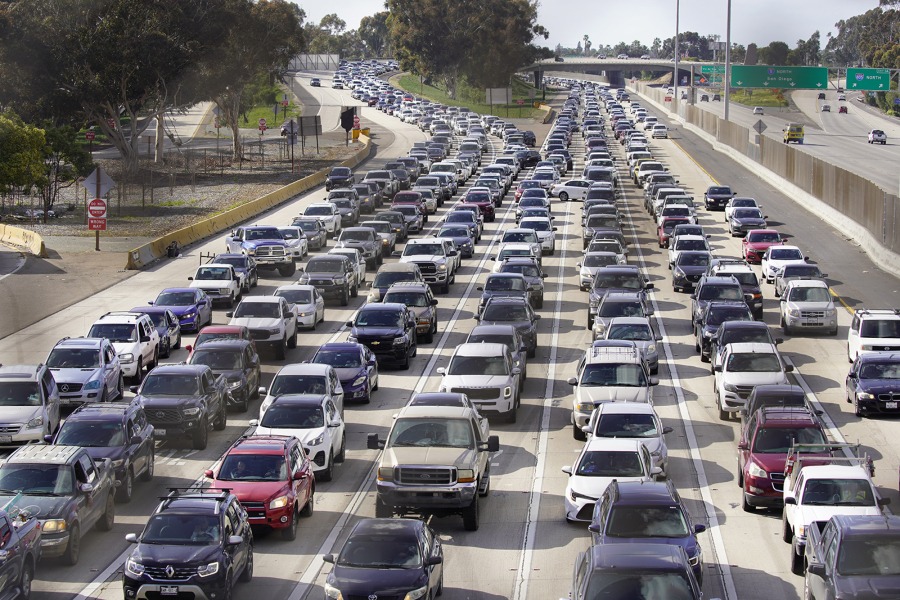Long southbound lines at the San Ysidro-Tijuana vehicle border crossing used to be expected on Fridays. But now it’s almost a daily occurrence, as drivers have noticed for months.
“In the five or six years I’ve been crossing the border every day, it has never been as bad as it is right now,” said Rafael Cueva, a Tijuana resident who works at a restaurant in Mission Valley.
The delays have been constant fodder in Facebook groups about border crossings where people often share their experiences with a photo showing where the line starts or a screenshot of their phone’s stopwatch to indicate how long they waited.
During a visit to Tijuana in November, Mexican President Andrés Manuel López Obrador vowed to take action and ease southbound traffic into Mexico, including opening all lanes at El Chaparral Port of Entry.
But Mexican officials said back then that it will take more than that to solve the problem.
The long delays are believed to be due in part to ongoing construction projects in Tijuana that have created traffic bottlenecks entering the city.
That includes repairs of the El Chaparral bridge — which connects traffic entering the U.S. to Tijuana’s Zona Rio — which is now scheduled to reopen in late May or early June after being closed for more than a year due to structural damage.
The long-awaited reopening was originally scheduled for January, but as construction work progressed, additional structural deficiencies were found, city officials said late last month.
“The deficiencies of the bridge have been repaired with highly specialized engineering, so the completion has been postponed so that when it reopens to traffic, it will support the capacity of 15,000 vehicles per day,” officials said in a news release.
Another ongoing project is the construction of an elevated highway between Playas de Tijuana and the Tijuana airport, which required the partial closure of lanes on Avenida Internacional, which connects traffic from the U.S. to Playas de Tijuana and Rosarito among other areas.
The project is expected to be completed later this year, before López Obrador’s term ends in October, Baja California Gov. Marina del Pilar Ávila said last month.
In addition, six of the 20 lanes at the El Chaparral border crossing are temporarily closed due to construction work to install vehicle screening technology.
Recently, the upgraded lanes — located on the far right side — were briefly seen in operation, but Mexican officials said that it was part of a test and that there’s still no reopening date.
To ease congestion, there has been a proposal to reopen at least three lanes of what was the old Puerta Mexico, which for years was the border crossing for vehicles from San Ysidro to Tijuana.
Baja California Secretary of Economy Kurt Honold said the city has already given the green light and that Mexican Customs officials are working on a plan.
“What we are looking for is to make the crossing more streamlined instead of sometimes, two or three hours,” he said Thursday to local media.
A possible date has not been determined.
Joaquín Luken, executive director of the Smart Border Coalition said that there’s still work to be done.
All construction projects and other proposals such as Puerta Mexico, must be completed in order to notice a change, he said. “Any one of (these projects) alone is not the solution, but all of them together are.”
Last year, Mexican officials estimated that around 50,000 vehicles per day cross from San Ysidro to Tijuana through the El Chaparral crossing. Peak hours are considered weekdays between 2 p.m. and 9 p.m., Luken said.
He and Mexican officials have openly wondered if the delays are also related to a possible increase in the number of people working in San Diego County who have moved to Tijuana due to the high cost of housing in Southern California. He said it is crucial to find a solution, as the long lines impact the competitiveness and dynamics of the border region.
Some cross-border workers have changed their schedules to avoid the traffic on their way home.
Cueva, who works as a restaurant server, said he had waited up to three hours to cross from San Ysidro to Tijuana, so he worked with his employer to change his work hours to leave later at night.
He said that sometimes he has waited more time in line to cross into Mexico than early in the morning to cross into the United States with his SENTRI card.

Luken said the Smart Border Coalition, too, has taken the waits into account, including changing the time of some of their meetings in San Diego for the convenience of attendees making the trip from across the border.
He said he hoped all pending projects to streamline southbound traffic will be completed this year. “I think we can make the southbound crossing easier,” he said. “I’m not saying there won’t be any traffic, but hopefully we can get back to what we were used to.”
Drivers on social media have also pointed out another factor that could sometimes add to delays: southbound operations by U.S. Customs and Border Protection before entering Mexico.
A spokesperson said that the federal agency “regularly conducts pulse and surge operations for southbound vehicle inspections in support of our mission to secure the border.”
“Travelers may continue to see these operations at the (port of entry) to correspond with the ebb and flow of traffic,” the spokesperson added.
CBP has inspection booths prior to the Mexican port of entry entrance that are irregularly staffed. These sporadic operations regularly focus on the detection of large amounts of currency, drugs, weapons and other contraband, officials said.


























